Net Zero Strategy
Simplo Technology's climate change actions include conducting greenhouse gas inventories and verification, actively participating in the SBT and RE100 renewable energy targets, and conducting climate change risk and opportunity assessments based on the TCFD framework.
|
|
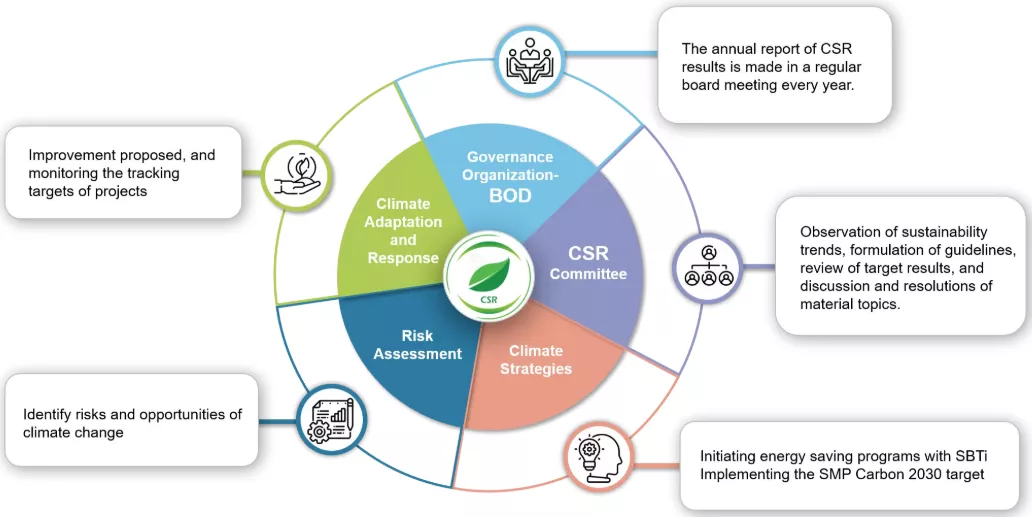 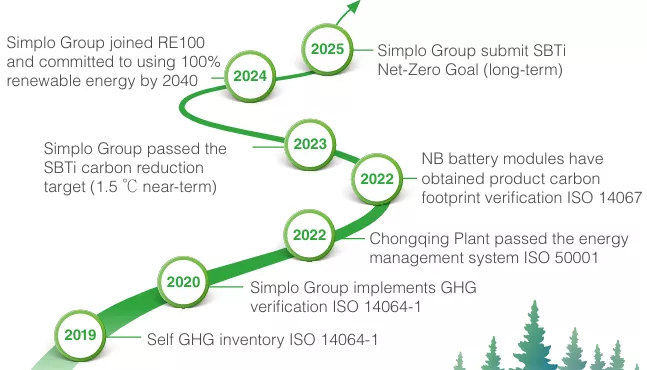 |
|
Renewable Energy Strategy
|
|
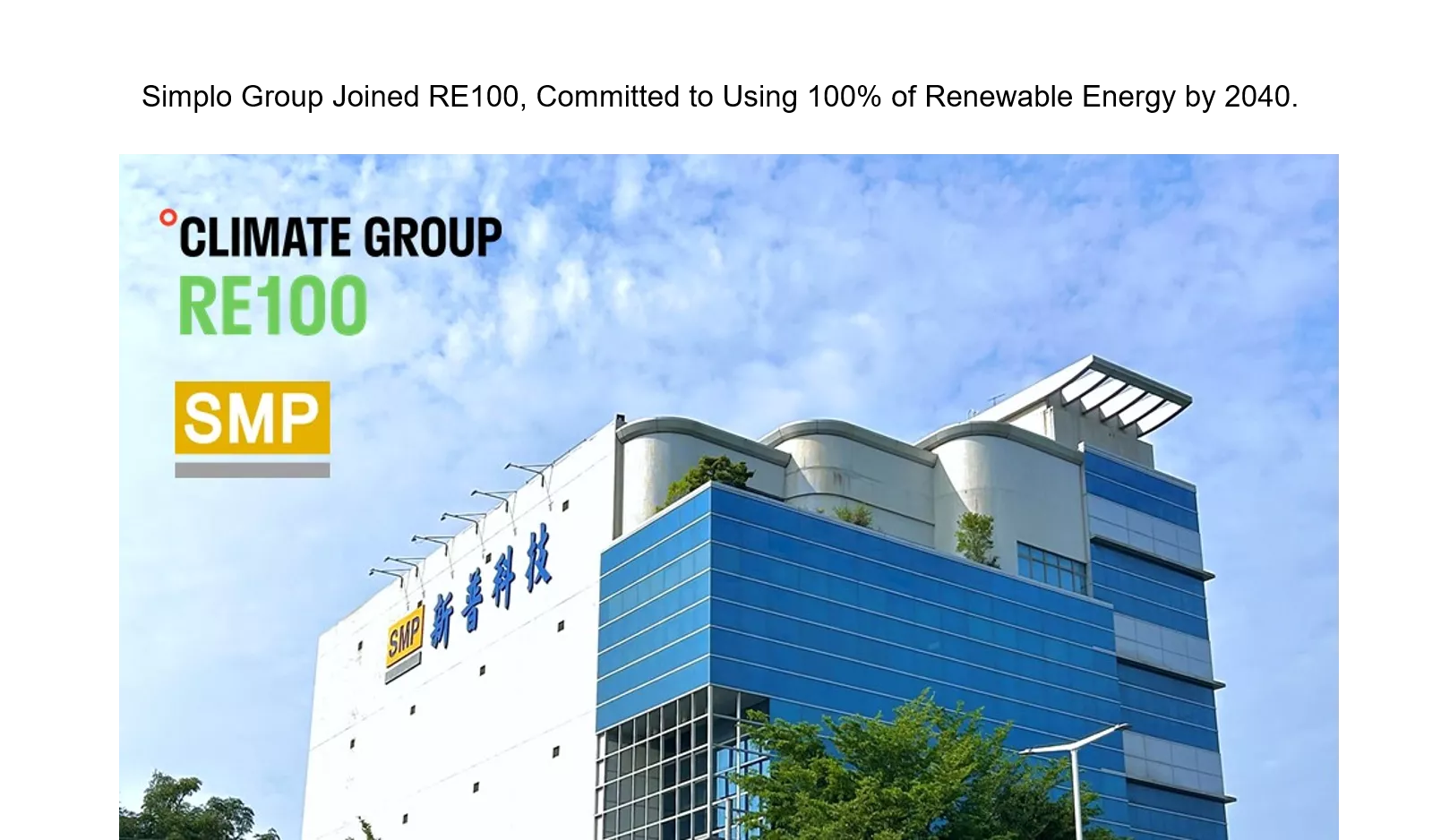 |
|
Science-Based Targets initiative (SBTi)
|
|
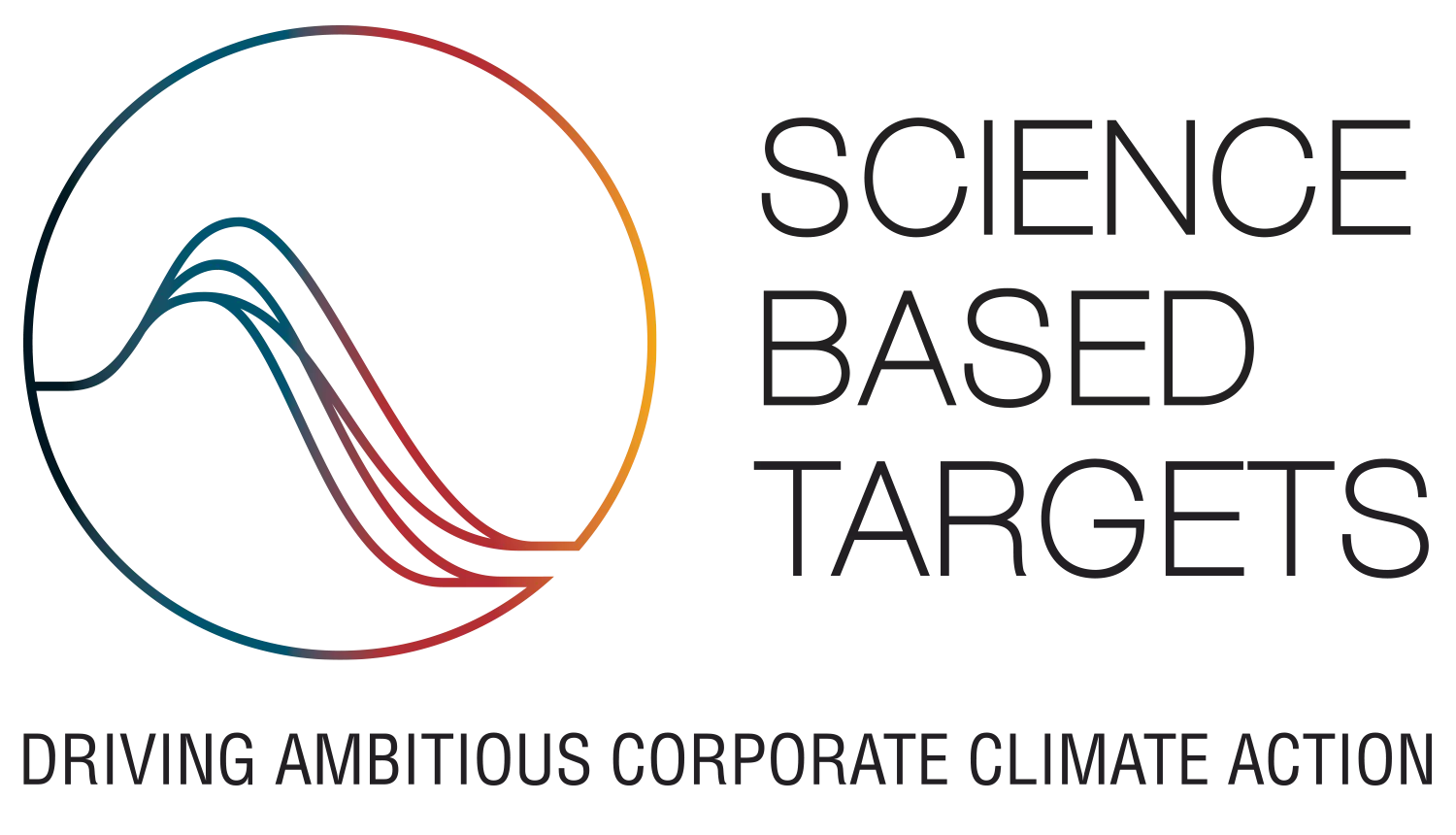 |
 |
|
Simplo signed the “SBTi Commitment” in 2021 and submitted the carbon reduction target in 2022. Simplo sets emissions reduction targets in line with a 1.5°C future, and Group’s near-term emissions reduction targets are approved by the SBTi in May 2023 (note1). Simplo is the first company in the global battery module manufacturing industry to pass the review. Simplo commits to reduce absolute scope1 and 2 GHG emissions 51% by 2030 from a 2020 base year. Simplo Technology also commits to reduce absolute scope3 GHG emissions from purchased goods and services 25% within the same timeframe.
In the future, Simplo will actively take carbon reduction actions, including: introducing the ISO 50001 management system, installing solar PV systems, signing renewable energy power purchase agreements, designing green products, using recycled materials, etc. At the same time, key suppliers will be included in the emission inventory and emission reduction actions, implement carbon reduction goals, and built a sustainable partner co-prosperity ecosystem.
Simplo Group Carbon 2050
|
|
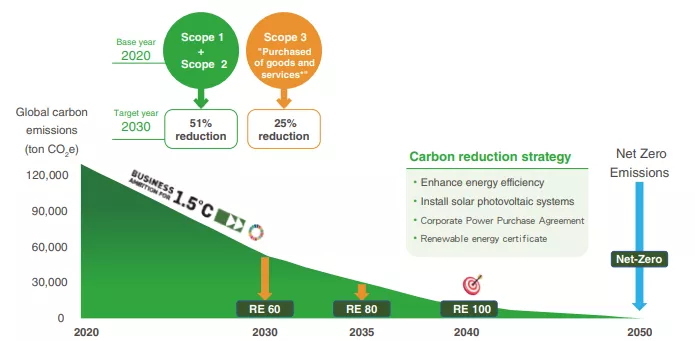 |
|
1. The data coverage of Simplo Group includes the headquarters and subsidiaries of the consolidated financial statements.
2. Purchasing goods and services classified according to the GHG protocol.
3. This near term target follows 1.5ºC path and has been certified by SBTi.
Internal Carbon Pricing (ICP) Strategy
Facing the generation of low-carbon emission or zero-carbon emission, the international community has promoted carbon fees and Carbon Border Adjustment Mechanism (CBAM), which will increase the carbon cost burden of the industry. Carbon risk management has become an important topic for companies, and companies are also aware of the profound impact of carbon risks on operations, thus launching the ICP mechanism. Simplo is committed to implementing the sustainable strategy blueprint, moving towards the goal of low carbon emissions or even net zero carbon emissions. In order to accelerate the group's carbon reduction actions, Simplo actively develops an ICP mechanism and tracks the international carbon trading market as reference for internalize external costs. Valuation of carbon emissions promotes the reduction of carbon emissions in the group's internal activities. In addition to developing low-carbon processes in the manufacturing process, it can also encourage employees to implement energy conservation and carbon reduction in their work, and strengthen the company's low-carbon culture.
Carbon Disclosure Project (CDP)
In 2024, Simplo Group was be awarded a “B” raating by CDP. According to the CDP guidelines, a B rating indicates that a company is showing some evidence of managing its environmental impact. At the same time, CDP announced the results of the 2024 Supplier Engagement Assessment (SEA), and Simplo Group was rated "A", which shows that our carbon reduction management efforts and action results are both affirmed by international evaluations.
Task Force on Climate-Related Financial Disclosures (TCFD)
Simplo Group references the core elements of TCFD for disclosing information related to “climate governance, strategy, risk management, and goals”. This helps assess climate-related risks and opportunities affecting business operations, formulate strategies and actions to address climate change, enhance transparency in disclosure, and implement corporate climate governance effectively.
|
Core elements |
Item |
Description |
|---|---|---|
|
1. Governance |
(a) Board of Directors supervision methods |
1. Regularly report on the results to the Board of Directors: |
|
2. Strategy |
(a) Climate-related risks and opportunities |
1. According to the internal risk control and management timeline, short-term is defined as 1 to 3 years, mid-term as 3 to 5 years, and long-term as 5 to 10 years. Collect stakeholder needs and climate change issues accordingly. |
|
3. Risk management |
(a) Evaluation process |
1. Referencing ISO 31000 risk management guidelines, establish a quantitative risk assessment method. Utilize the operation of a risk working group to conduct risk assessments, enabling risk monitoring and management. |
|
4. Indicators and targets |
(a) Indicators for assessing climate-related risks and opportunities |
1. Passed the review of the SBTi (1.5 ℃ near-term) target, using 2020 as the base year, aim to reduce absolute Scope 1 and 2 GHG emissions by 51% by 2030. Additionally, reduce absolute Scope 3 emissions related to “purchased goods and services” by 25%. |
Climate Scenario Analysis
Based on the latest Sixth Assessment Report (AR6) released by the Intergovernmental Panel on Climate Change (IPCC) in 2021, Simplo Technology adopts the data collected by the Taiwan Climate Change Projection and Information Platform, which includes the latest information from the Coupled Model Intercomparison Project (CMIP) Phase 6 (CMIP6) used by the IPCC AR6. The Company adopts ensemble models and Shared Socioeconomic Pathways (SSP) for analysis:
• Taking into account GHG emissions from four different social and economic scenarios, including SSP1-2.6 low emissions scenario, SSP2-4.5 moderate emissions scenario, SSP3-7.0 high emissions scenario, and SSP5-8.5 very high emissions scenario, these scenarios project changes in annual average temperature, daily maximum temperature, and precipitation in Taiwan by 2050.
• Using the observed annual average temperature of 22.4℃ in 2020 as a baseline, by 2050, under the SSP2.6 scenario, Simplo (Taiwan)'s annual average temperature will rise to 23.3℃, and under the SSP8.5 scenario, it will increase to 23.9, with an increase ranging between 0.9℃ and 1.5℃.
Using the observed precipitation of 2.9 mm/day in 2020 as a baseline, by 2050, under the SSP2.6 scenario, Simplo (Taiwan)'s precipitation will decrease to 2.7 mm/day, and under the SSP8.5 scenario, it will increase to 4.2 mm/day. Without mitigation actions, the frequency of extreme rainfall events will gradually increase. Enhancing emergency response capabilities and maintaining operational resilience will become operational risk issues faced by the Company. For the risk of heavy rain and flooding, we adopt the 3D disaster potential map (inundation potential map) from the National Science and Technology Center for Disaster Reduction for estimation. The inundation potential simulation is conducted with 24-hour duration rainfall reaching 650mm, indicating that the headquarters is not at risk of flooding. In the past five years, there was no flooding investigation site near the headquarters.
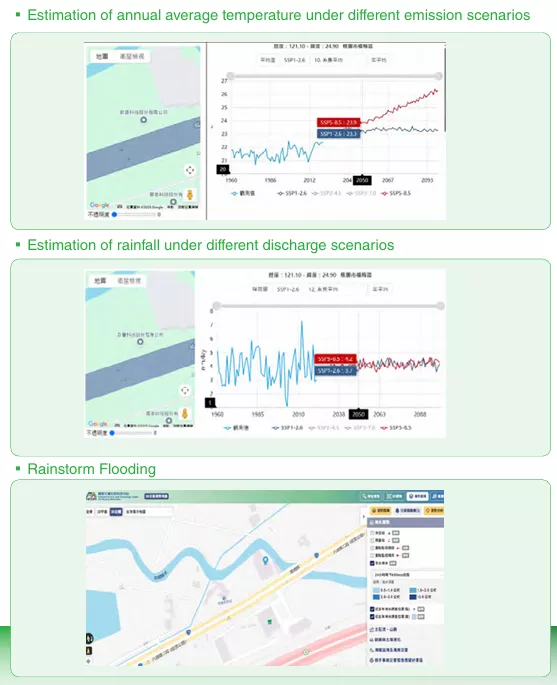
I. Financial impacts and response to climate-related risks
|
Type |
Climated-related risks | Potential financial impact | Response actions |
|---|---|---|---|
|
Transformation risk |
Policies and regulations |
Responding to regulatory requirements leading to increased operational costs |
1. Energy conservation and carbon reduction solutions |
|
Technology |
1. Customers request the use of renewable energy |
1. Low-carbon technology transformation and introduction of low-carbon processes |
|
|
Market |
1. Customer and market demand changes affecting orders |
1. Assessing new markets for green transformation |
|
|
Reputation |
Inability to meet customer or stakeholder expectations leading to revenue decline |
1. Increase stakeholder trust |
|
|
Physical risk |
Immediateness |
1. Decreased production capacity or disruptions (e.g. shutdowns, transportation difficulties, supply chain interruptions) |
1. Enhance emergency response capabilities |
|
Long-term |
Chronic climate change (e.g. average temperature rise/sea level rise) |
1. Enhance emergency response capabilities |
II. Financial impacts and response to climate-related opportunities
|
Type |
Climated-related opportunities | Potential financial impact | Response actions |
|---|---|---|---|
|
Resource efficiency |
Improve operational management efficiency |
1. Enhance resource usage efficiency |
Introducing post-consumer recyclable plastic materials (PCR) and reusable packaging materials (Tray) |
|
Energy sources |
Using low-carbon energy and evaluate participation in the carbon trading markets |
1. Reduce the risk of GHG emissions |
1. Energy conservation and carbon reduction solutions |
|
Products and services |
1. Increasing opportunities for low-carbon products and services |
Harnessing the advantages of new technologies to enhance the performance of various products and achieve market-leading energy efficiency |
Meeting climate adaptation needs through innovative solutions to increase revenue |
|
Resilience |
1. Improve the adaptability and resilience of business operations |
1. Assess supply chain operational capabilities |
1. Increase R&D capacity and continuous innovation |

Greenhouse Gas Inventory
Simplo Group refers to ISO 14064-1:2018 GHG inventory standards and guidelines such as the Greenhouse Gas Protocol published by the World Resources Institute (WRI) to establish a GHG inventory mechanism. Since 2019, annual GHG inventory have been conducted at each plant to comprehensively understand GHG usage and emissions. Starting from 2021, these data have been verified by third parties.
The greenhouse gases inspected include: carbon dioxide (CO2), methane (CH4), nitrous oxide (N2O), hydrofluorocarbons (HFCs), perfluorocarbons (PFCs) and other gases.
Direct and energy indirect GHG emissions (Scope 1 and Scope 2)

| Item | Unit | 2020 | 2021 | 2022 | 2023 | 2024 |
|---|---|---|---|---|---|---|
|
Direct (Scope 1) GHG emissions |
ton CO2e |
2,355 |
1,997 |
1,911 |
1,949 |
1,766 |
|
Indirect (Scope 2) GHG emissions |
ton CO2e |
127,178 |
84,391 |
13,568 |
26,179 |
13,482 |
|
Total GHG emissions |
ton CO2e |
129,533 |
86,388 |
15,479 |
28,128 |
15,248 |
|
Emission intensity |
ton CO2e / NTD million in revenue |
1.52 |
0.90 |
0.16 |
0.33 |
0.19 |
|
Emission intensity |
kg CO2e / PCS |
0.50 |
0.32 |
0.08 |
0.16 |
0.09 |
Note
1. The disclosure scope of the data in the above table is the parent and subsidiary companies of Simplo Group's consolidated financial statements (Not included in Simplo Vietnam).
2. The GHG Scope 1 and Scope 2 emissions of Simplo Vietnam in 2024 are 746.54 metric tons CO2e (self-inventoried according to ISO 14064-1).
3. The inventory is done with the operation control. The figures of the GHG inventory are certificated by third-party.
4. GWP value is taken from the IPCC 2021 Sixth Assessment Report.
|
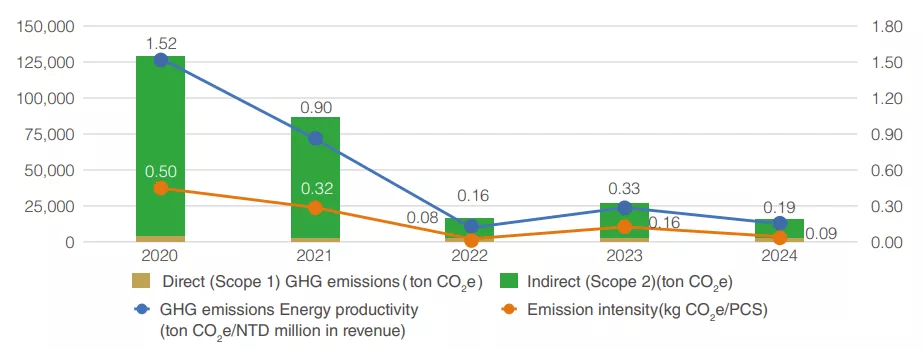 |
Other indirect GHG emissions (Scope 3)
Simplo has established a GHG inventory and assesses the significance of the items in the C1-C15 categories by GHG protocol. Based on the significance of the analysis results, 7 categories were included in the inventory items, and verified by a third party in accordance with ISO 14064-1. The item with the highest emissions is the purchased goods and services in 2024, accounting for 93%, which is a key item for the subsequent reduction.
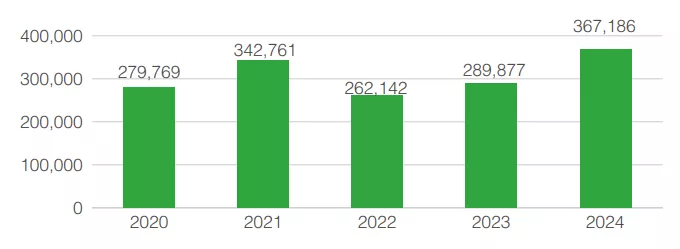 |

| Scope 3 Category | 2024 carbon emissions (ton CO2e) |
|---|---|
| C1 Purchased Goods and Services | 341,940 |
| C3 Fuel- and Energy-Related Activities (Not Included in Scope 1 or Scope 2) | 9,150 |
| C4 Upstream Transportation and Distribution | 5,681 |
| C5 Waste Generated in Operations | 39 |
| C6 Business Travel | 856 |
| C7 Employee Commuting | 1,070 |
| C9 Downstream Transportation and Distribution | 8,450 |
Note:
1. The disclosure scope of the data in the above table is the parent and subsidiary companies of Simplo Group's consolidated financial statements (Includes Simplo Vietnam, 2024 GHG emissions category 1 cells).
2. Including GHG protocol categories 1, 3, 4, 5, 6, 7, 9.
3. GWP value is taken from the IPCC 2021 Sixth Assessment Report.
Internal Carbon Pricing, ICP
The Simplo Group, with reference to international carbon fees and industry carbon prices, has set a shadow price range of USD 30–50 per metric ton of CO₂e. This pricing framework serves as a critical decision-making parameter for all business units in product design, process optimization, and the planning of energy-efficiency and carbon-reduction initiatives.
In 2024, the Simplo Group implemented a total of eight initiatives, achieving energy savings of 12,860 GJ, equivalent to a reduction of approximately 2,348.3 metric tons of carbon emissions. Through the collective efforts of all employees, the Group’s total Scope 1 and Scope 2 carbon emissions in 2024 decreased by 88% compared to the 2020 base year, thereby achieving the interim carbon-reduction target under the SBT framework.

